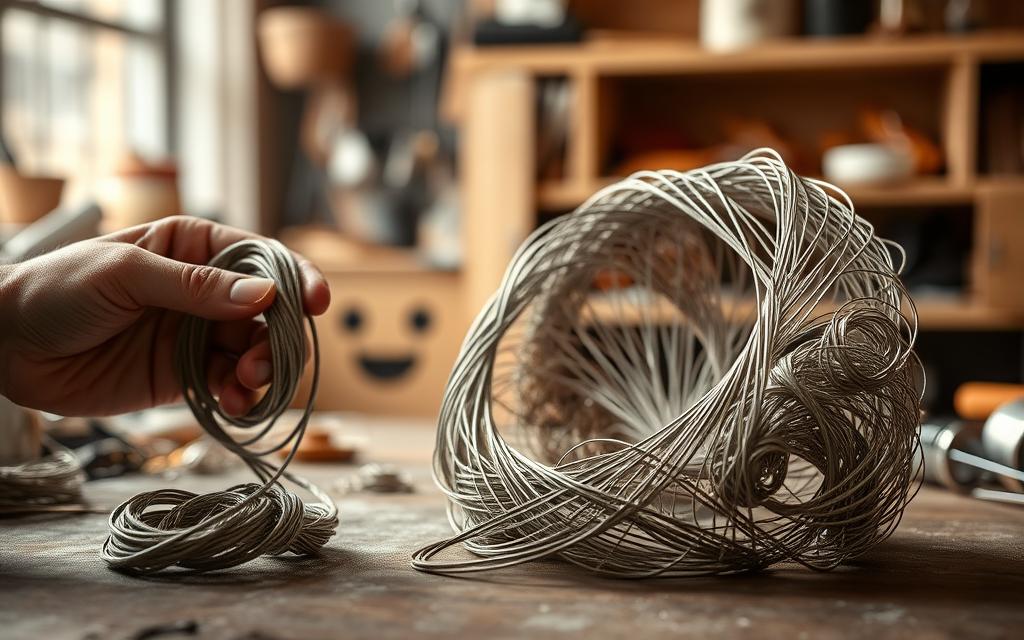Musicians today are increasingly aware of their environmental impact. Many wonder what to do with old strings from their instrument. While tossing them in the trash seems easy, it’s not the most eco-friendly choice.
Creative minds have found ways to reuse these materials. Some turn them into jewelry, garden trellises, or even cheese-cutting tools. However, disposal challenges like rust and sharp ends make recycling a better option.
Recycling programs exist, but they’re not as simple as curbside pickup. This article explores the environmental impact, material considerations, and DIY solutions for sustainable string disposal.
Why Recycling Guitar Strings Matters
Every year, millions of pounds of metal from strings end up in landfills. This waste contributes to a growing environmental crisis. Proper disposal methods can make a significant difference.
The Environmental Impact of Discarded Strings
Annually, 1.5 million pounds of metal from instrument strings are thrown away. This is equivalent to the weight of 2.5 Statues of Liberty. Most of this waste ends up in landfills, which are rapidly reaching capacity.
According to the Waste Business Journal, the U.S. could run out of landfill space by 2036. This makes it crucial to find sustainable alternatives for disposal. Recycling strings can help reduce this burden.
How Recycling Contributes to Sustainability
Recycling metals like nickel, steel, and brass reduces the need for mining. This process conserves natural resources and lowers energy consumption. For example, recycled steel can be used in construction materials, while brass finds new life in hardware and fittings.
Many companies are now prioritizing sustainability. Programs like D’Addario’s Playback String Recycling encourage musicians to recycle their strings. These efforts contribute to a circular economy, where materials are reused rather than discarded.
“Every small action counts. Recycling strings is a simple step toward a greener future.”
| Material | Recycled Into |
|---|---|
| Nickel | Batteries, turbine blades, coins |
| Steel | Construction materials, cutting tools |
| Brass | Hardware, fittings, musical instruments |
By recycling, individuals can play a part in reducing waste and supporting sustainability. Together, these efforts can help preserve landfill space and protect the environment for future generations.
Are All Guitar Strings Recyclable?
Not all strings are created equal when it comes to recycling potential. Their composition plays a significant role in determining how they can be repurposed or processed. Understanding the materials used in their construction is the first step toward sustainable disposal.

Materials Used in Guitar Strings
Strings are typically made from a variety of metal and synthetic components. Common materials include brass, nickel-plated steel, and nylon. Brass is often used for its durability and tone, while nickel-plated steel offers strength and corrosion resistance. Nylon, on the other hand, is lightweight and flexible, making it ideal for certain types of instruments.
Recycling Potential of Different String Types
Each material has unique recycling applications. Brass can be repurposed into fasteners or new musical instruments. Nickel-plated steel finds new life in batteries, turbine blades, and even coins. Carbon steel is often used in construction, while stainless steel is ideal for utensils and other household items.
Nylon, however, presents challenges. Unlike metals, it cannot be fully recycled. Instead, it is often downcycled into industrial pellets or other lower-grade products. Separating synthetic strings from metal ones is crucial for specialized processing.
Stainless steel and carbon steel differ in their corrosion resistance, which affects their recycling efficiency. Stainless steel is more durable and easier to process, while carbon steel requires more care to prevent rust during recycling.
By understanding these differences, musicians can make informed decisions about how to dispose of their old strings responsibly.
How and Where to Recycle Guitar Strings
Finding eco-friendly ways to dispose of old instrument parts is easier than you think. Several options are available, from local facilities to specialized programs. Each method ensures your materials are handled responsibly.
Local Recycling Centers and Scrapyards
Many cities have recycling centers or scrapyards that accept metal components. Before dropping off your items, prepare them properly. Coil the strings to prevent tangling and store them in bulk for easier processing.
Call ahead to confirm acceptance policies. Some facilities may require a minimum weight, often measured in pounds. This ensures efficient handling and reduces processing costs.
The D’Addario Playback String Recycling Program
D’Addario’s recycling program is a popular choice for musicians. It partners with TerraCycle to process used strings into new products. To participate, enroll via the Players Circle website and request a free shipping label.
This program has a 5-pound minimum requirement. It’s currently available in the U.S., with restrictions for Hawaii and international locations. Due to high demand, a waitlist may apply.
Alternative Recycling Options
For smaller quantities, consider Restrung Jewelry. They accept mailed strings at PO Box 792615 and transform them into upcycled accessories. This initiative also supports charitable causes.
Music schools and luthiers often qualify for prepaid TerraCycle labels. These bulk recyclers can collect and ship larger quantities, making it a convenient point of disposal.
Check the TerraCycle drop-off locator for facilities handling under 5 pounds. Ensure synthetic materials are separated and placed in the correct bin for specialized processing.
“Every small step toward sustainability makes a difference. Recycling your strings is a simple yet impactful choice.”
Creative Ways to Reuse Old Guitar Strings
Transforming old strings into something new is both creative and eco-friendly. Instead of discarding them, consider giving them a second life. This approach not only reduces waste but also sparks innovation.

DIY Projects and Upcycling Ideas
Old strings can become the foundation for exciting DIY projects. Here are a few ideas to get started:
- Coiled Coasters: Use glue or wire techniques to create unique coasters. These make great gifts or personal items.
- Bookmarks with Beads: Add beads to strings for a stylish bookmark. This is a simple yet effective way to repurpose them.
- Cat Toys: Craft playful toys for your pets. Ensure the strings are clean and safe before use.
Before starting, clean the strings with alcohol wipes to remove rust and dirt. This ensures your products are safe and durable.
Donating Strings to Musicians in Need
Another meaningful way to reuse old strings is by donating them. Organizations like Second Strings redistribute these materials to low-income artists. This helps support the music community while promoting sustainability.
ReStrung Jewelry also accepts donated strings. They transform them into upcycled accessories, available on their Etsy store. Their carbon-neutral shipping ensures eco-friendly practices.
“Donating old strings is a simple act that can make a big difference in someone’s life.”
| Program | Details |
|---|---|
| Second Strings | Redistributes strings to low-income musicians |
| ReStrung Jewelry | Creates upcycled accessories from donated strings |
| Wear Your Music | Partners with celebrities for string upcycling |
By donating, you contribute to a circular economy and support those in need. It’s a win-win for the environment and the music community.
Conclusion
Taking small steps toward sustainability can have a big impact. Every year, millions of pounds of metal from strings end up in landfills, adding to environmental challenges. Recycling these items is a simple yet effective way to reduce waste and conserve resources.
Options like TerraCycle partnerships and local scrapyards make recycling accessible. Creative reuse, such as DIY projects or donations, also offers eco-friendly alternatives. Combining these efforts with sustainable purchases, like those from Strings and Beyond, amplifies your positive impact.
Join programs like Players Circle, explore DIY ideas, or donate to support others. Every action counts toward a greener future. Start today and make a difference.







